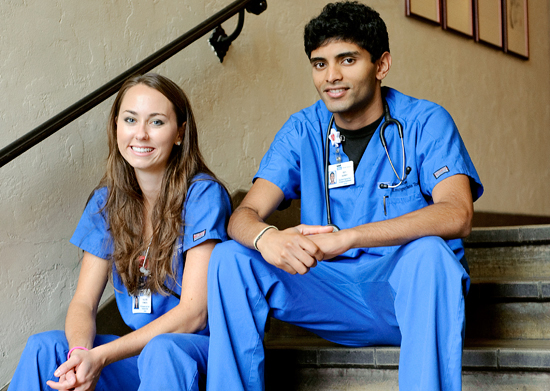When a patient comes into the Ronald Reagan UCLA Medical Center suffering from severe gunshot wound complications, Rey Henry is ready.
He prepares all necessary medical trays for the doctors, monitors the patient’s vital signs, takes his or her blood pressure, and assists the doctor with physical procedures.
If a patient dies in the trauma bay, Henry is responsible for putting the deceased patient in a body bag.
He routinely sees people suffering from gunshot wounds, motor vehicle accidents, chest injuries and severe alcohol intoxication during weekly shifts in the emergency room.
“I start at 7 a.m. and then am on my feet for essentially 12 hours straight,” he said.
Henry, a fourth-year history student, is one of four UCLA undergraduates working as emergency trauma technicians in the emergency room. ETTs are certified emergency medical technicians, who also go through 144 hours of additional training in using medical equipment, reading electrocardiograms and splinting.
They work solely in the emergency room and are the only undergraduates who are allowed to assist in procedures in the trauma bay.
Tiffany Chow, an ETT and a fourth-year physiological science student, works the night shift on the weekends from 7 p.m. to 7 a.m. Often she does her shift on Sunday, goes home to take a quick shower and then attends her 8 a.m. class.
“It’s intense, but it makes me really excited,” Chow said. “You really feel you’re really making a difference.”
Chow also said she has learned a lot from chatting with nurses and doctors. One night during a break, a doctor taught her how to do a surgical suture because Chow had showed interest.
“I thought it would be more intimidating, but everyone is very supportive. It’s like a huge family,” she said.
In every shift, each ETT is assigned a different unit. These include the trauma bay, the triage, for less pressing injuries, and orthopedics.
ETTs also have a lot of interaction with patients, and every ETT is usually assigned eight patients during a shift. They make sure the rooms are fully stocked and assist the patients in any way they can, from bringing them extra blankets to helping them go to the bathroom. They are also responsible for transporting patients from the ambulance and the helicopter pad to the ER and for taking them to get X-rays and CT scans.
When the ETTs come in for their shift, they have no idea what types of traumas they might see, said Valerie Powers, an ETT and a fourth-year study of religion student.
“Everyone is always moving really fast. When you see a really bad trauma it doesn’t hit you right away because you are running on so much adrenaline,” Powers said. “The first time I saw a really bad trauma, it was really hard, but I have learned how to cope.”
Though there is little downtime, ETTs still have some time to relax.
As her shift nears its end at 6 a.m., Chow often gets what is known as the 6 a.m. giggles when she and others around her begin cracking more jokes and laughing a lot because they are so tired.
Though the program is hard work, Henry, Chow and Powers all said they are always excited to come into work.
“Being part of this program reinvigorates my passion for medicine,” Powers said.
ETTs are not the only undergraduates allowed in the trauma bay. Other undergraduates involved in research studies are allowed to observe procedures. The Emergency Medicine Research Associates compile data on how trauma surgeons and ER doctors administer CT scans, and students in the UCLA Stroke Student Research Program identify stroke patients in the ER and alert the stroke team physicians if necessary.
Duy Nguyen, a coordinator of EMRA, sees his time in the trauma bay as great preparation for a career as a doctor because he can ask doctors questions whenever he is in the ER.
“I love watching how everything happens and how doctors react to traumas,” Nguyen said.
